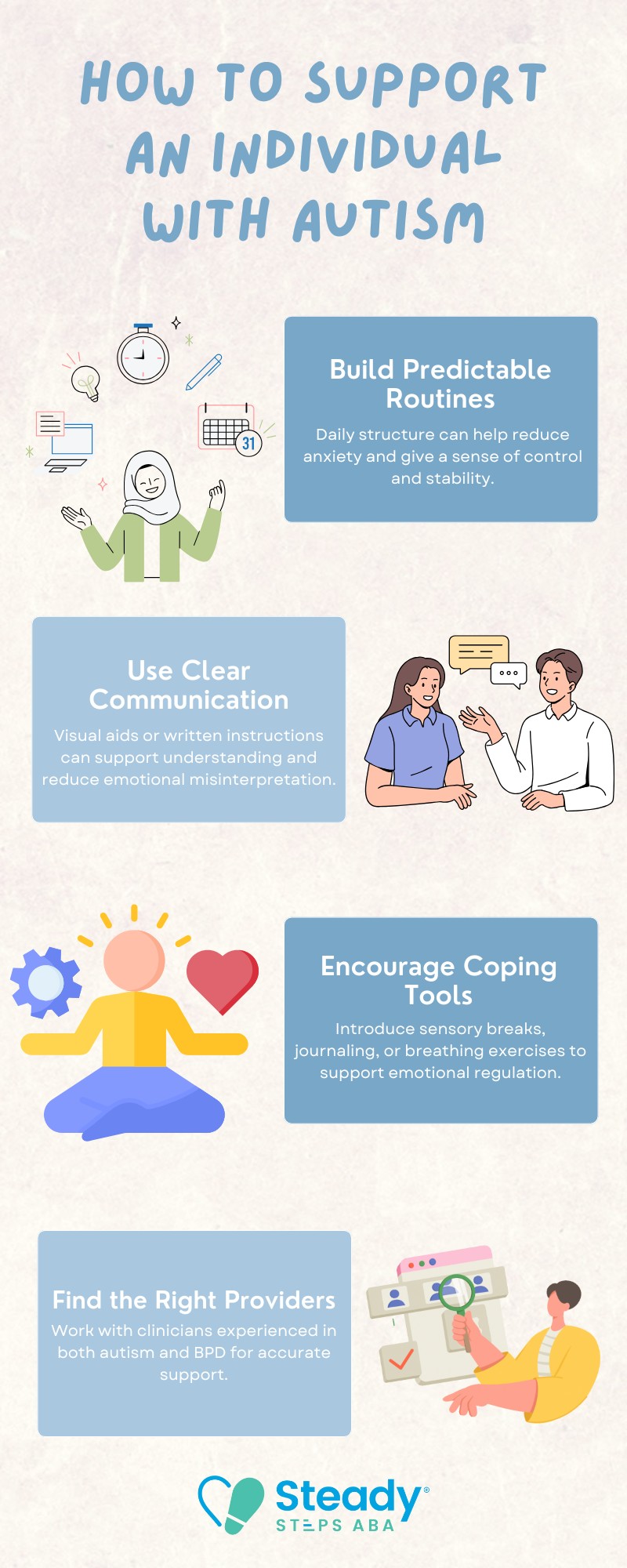Key Points:
- Borderline Personality Disorder (BPD) and Autism Spectrum Disorder (ASD) can share overlapping traits, making diagnosis complex.
- Emotional regulation, empathy, and communication present differently in each condition.
- Understanding both the differences and similarities helps families seek appropriate support, such as ABA therapy.
Understanding the distinction between borderline personality vs autism can be confusing for parents and even clinicians. Both conditions affect emotional expression, relationships, and social communication, but their roots and expressions are quite different.
According to the CDC, autism is a neurodevelopmental condition that affects approximately 1 in 31 children in the US. Early misdiagnosis is not uncommon, especially when autism in adults or women is underrecognized due to masking or internalized traits. This article breaks down the key similarities and differences between autism and BPD, what signs to watch for, and how therapeutic support can help.
Is Borderline Personality vs Autism a Valid Comparison?
Yes, comparing borderline personality vs autism can be valid, but they are fundamentally different disorders. While both may involve social difficulties and emotional dysregulation, autism is a neurodevelopmental condition present from early childhood, whereas BPD is a personality disorder often shaped by environmental factors and trauma.
Although the symptoms may sometimes appear similar on the surface, such as mood swings or interpersonal struggles, the underlying causes and patterns of behavior distinguish the two. Understanding this difference is key to seeking the right diagnosis and support strategy.
What Is Borderline Personality Disorder?
Borderline Personality Disorder (BPD) is a mental health condition characterized by chronic instability in mood, behavior, self-image, and interpersonal relationships. People with BPD may experience intense emotions, impulsive behavior, and a fear of abandonment. These emotional reactions often feel overwhelming and may last for minutes or hours rather than days.
BPD typically begins in late adolescence or early adulthood and is influenced by both genetic predisposition and early-life trauma. It is classified under personality disorders and is considered more episodic than developmental.
While these behaviors can be distressing, understanding them as part of a diagnosable disorder is crucial for managing symptoms and accessing support.
What Is Autism Spectrum Disorder?
Autism Spectrum Disorder (ASD) is a lifelong neurodevelopmental condition that impacts how people interact, interpret sensory information, and connect socially. Because experiences vary widely, it’s considered a “spectrum,” reflecting diverse strengths and challenges among individuals.
Unlike BPD, autism is present from early development—even if not diagnosed until adulthood. Many autistic individuals, especially those with average to above-average intelligence (formerly labeled “high-functioning”), may not be diagnosed until later in life, especially if their symptoms are masked.
While emotional outbursts can occur in autism, they are usually triggered by sensory overload, social confusion, or routine disruption, not emotional manipulation or abandonment fears as in BPD.

Key Differences Between BPD and Autism
Although both conditions impact emotional expression and relationships, their differences lie in cause, timing, and behavioral patterns. Understanding these distinctions helps guide appropriate treatment options.
Below are the major distinctions:
1. Origin and Onset
Autism is neurodevelopmental and typically recognized in early childhood, while Borderline Personality Disorder (BPD) often develops during adolescence or adulthood, frequently as a response to trauma or chronic emotional neglect.
2. Emotional Regulation
Autistic individuals may struggle with emotional regulation due to sensory overload or executive dysfunction. BPD often involves intense emotional swings, frequently tied to fear of abandonment or unstable relationships.
3. Empathy and Social Interaction
Autism may involve difficulty interpreting social cues, but empathy is often intact. BPD may involve heightened emotional empathy but impaired cognitive empathy, often resulting in unpredictable interpersonal behavior.
4. Sense of Identity
Those with autism often have a consistent self-identity but may feel “different.” Individuals with BPD frequently experience an unstable or fragmented sense of self, shifting values, and confusion about who they are.
5. Communication Style
Autistic communication may be direct, literal, or socially unconventional. In contrast, BPD communication can fluctuate between intense closeness and withdrawal, often influenced by perceived emotional threats or interpersonal misunderstandings.
Can Someone Have Both Autism and BPD?
Yes, it is possible to have both Autism Spectrum Disorder and Borderline Personality Disorder. This is known as a dual diagnosis. However, overlapping symptoms can sometimes lead to misdiagnosis, especially in autistic females, who may present with heightened emotional distress or interpersonal difficulties.
Accurate diagnosis requires a detailed developmental history and evaluation by professionals who understand both conditions. Misdiagnosis can delay effective interventions and contribute to worsening mental health.
Similarities Between Autism and BPD
Despite their differences, autism and BPD share certain surface-level similarities, which can confuse parents and clinicians during early diagnosis. These overlaps are not identical but can appear related in behavior.
Shared traits include:
- Difficulty forming and maintaining relationships
- Emotional sensitivity or reactivity
- Strong responses to perceived criticism
- Struggles with identity, especially in social settings
- Need for routine or control
It’s essential to look at the underlying motivations behind these behaviors when assessing for autism vs borderline traits. For example, avoidance in autism may be rooted in sensory overwhelm, while avoidance in BPD may stem from fear of rejection.
How Can Parents and Loved Ones Support Someone?
If you’re a parent or caregiver, understanding how to support a child or loved one with either autism, BPD, or both begins with knowledge and compassion. Avoid jumping to conclusions and instead seek out an evaluation with a neuropsychologist, developmental pediatrician, or mental health professional.
Once a clear diagnosis is established, tailored support strategies can help your loved one thrive.
Support strategies include:

Every person is different. Respecting individual differences and encouraging self-awareness can empower them toward independence and self-advocacy.
Why Does the Difference Matter?
The distinction between borderline personality vs autism matters because treatment paths differ. BPD often responds well to dialectical behavior therapy (DBT), while autism benefits from behavioral supports like Applied Behavior Analysis (ABA), speech therapy, and occupational therapy.
Mislabeling one for the other may delay effective interventions. More importantly, individuals who are misunderstood may begin to internalize blame or shame for their differences, further complicating mental health outcomes.
Getting the diagnosis right helps individuals access the services and community they need. It also empowers families to be better advocates.
Support Everyday Progress With ABA Therapy
Applied Behavior Analysis (ABA) can be an essential support for individuals with autism. While ABA is not typically used to treat BPD directly, it can help autistic individuals learn adaptive skills, improve communication, and reduce behaviors that interfere with daily living.
At Steady Steps ABA, we offer compassionate, personalized ABA therapy in Maryland, designed to meet the unique needs of each individual on the spectrum. Whether your loved one is navigating autism alone or in combination with another diagnosis, our team works closely with families to build meaningful progress.
Get in touch with us to learn how our team can support your child or family member with evidence-based, person-centered care.






